If you’re on the lookout for a new special side dish, you need to try out these classic Southern German bread dumplings, also known as Semmelknödel.
In Germany, these are beloved specialties.
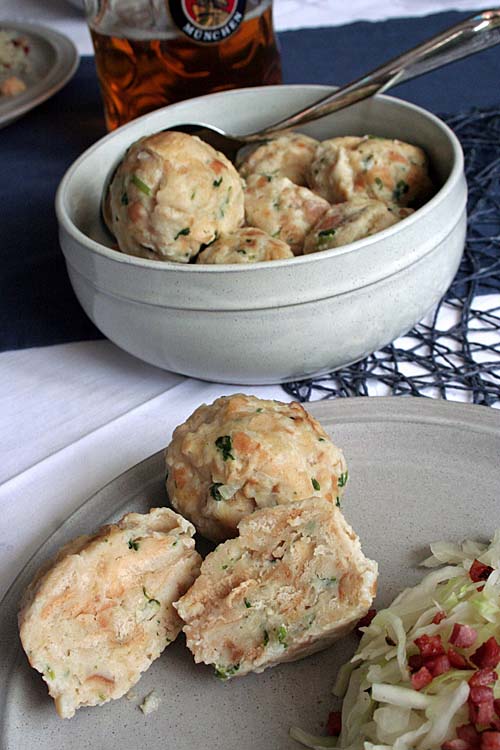
These dumplings are especially great to prepare when you’ve got some older rolls or slices of white bread left over that you would like to use up.
The buns are cut into chunks, soaked in warm milk, and mixed into a dough with some additional flour and eggs. Parsley is typically added, but thyme also works quite nicely.

Here’s another tip: Prepare the recipe with leftover soft pretzels instead of white bread! This is another popular variety that’s just as delicious as the bread version.
The dumplings pair well with savory meat dishes, and green salads. They also make a nice addition to broths and soups, in place of noodles or matzoh balls. I personally love them with a classic Bavarian cabbage salad with warm bacon.
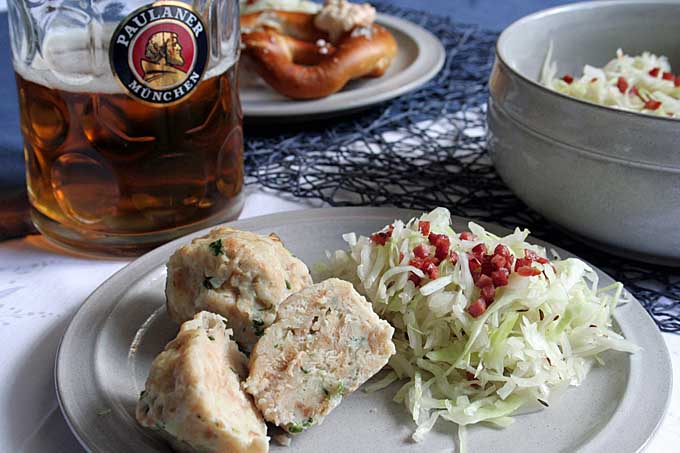
Whether intentionally or because you just can‘t manage to eat them all in one sitting, here is a great way to jazz them up the next day:
Cut the dumplings into slices and fry them in a pan with some butter until crispy. Not only is this really tasty, it’s a simple save some time in the kitchen the next day.
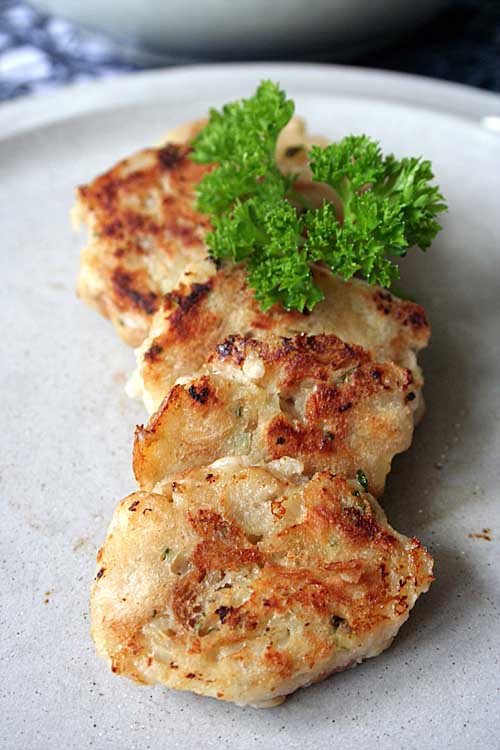
The only thing you should avoid is heating these up in your microwave. This tends to extract all the moisture, making the dumplings dry and flavorless.
What will you serve these with, in an effort to use up some of your kitchen leftovers in a tasty and satisfying way? Let us know in the comments!
The Recipe
- 8 day-old white buns or slices of white bread
- 1 cup 2% milk, heated
- 1 onion peeled and chopped
- 1 teaspoon butter
- 2 eggs
- 2 Tablespoons flour
- Pinch of salt
- 1-2 handfuls fresh parsley chopped
- Cut the buns into thin slices and place in a bowl. Pour the warm milk over the sliced buns and leave to soak.
- Saute the onions in a pan with the butter until golden brown. Set aside to cool for a moment.
- In a bowl, thoroughly knead the eggs, flour, salt, parsley, onions, and the soaked buns until combined thoroughly.
- Bring a large pot of salted water to a boil.
- Wet your hands (for a better grip) and form 8-10 dumplings of equal size. Carefully place them in the boiling water and simmer over low heat for about 15 minutes. You'll know they're ready when they float up to the surface on their own and gently rotate. They should feel firm when you remove them from the water.
Nutritional Information*
Cooking by the Numbers…
Step One – Prepare the Bread
Slice the bread into small pieces and add them to a bowl. Pour milk on top of the buns and let them soak.
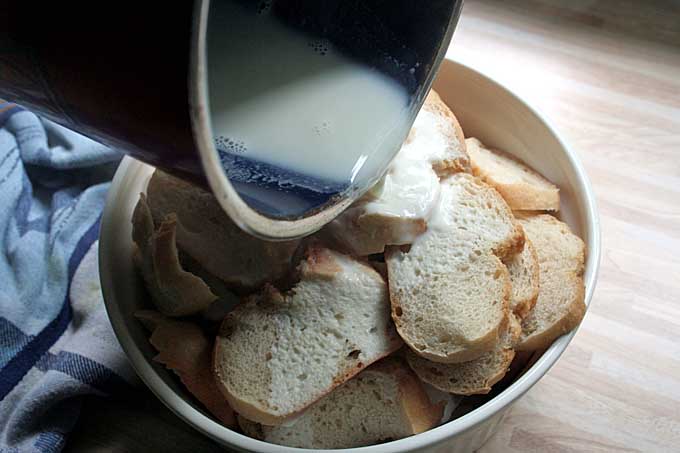
Step One – Sauté the Veggies
Dice the onions and parsley (optional). Add butter to a skillet and let warm for a minute or two on medium low.
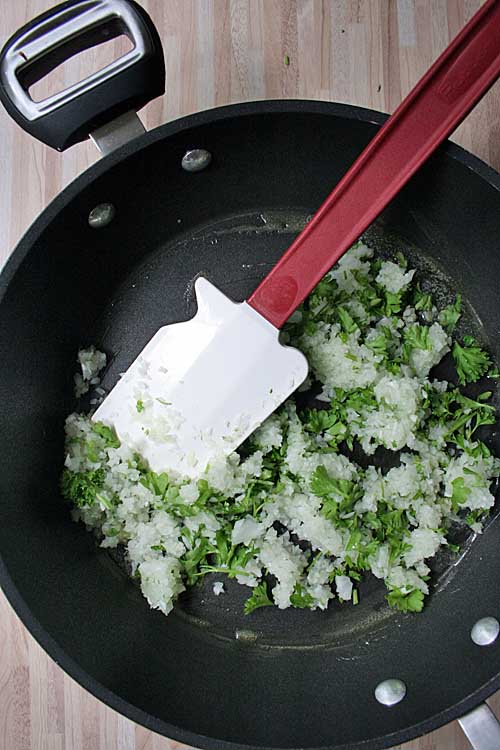
Add the add onions and parsley and sauté until golden brown. Remove from pan and allow to cool.
Step Three – Blend
Add the parsley and onions to the bowl of bread and mix in the eggs, flour, and salt and knead until all of the ingredients are combined thoroughly.
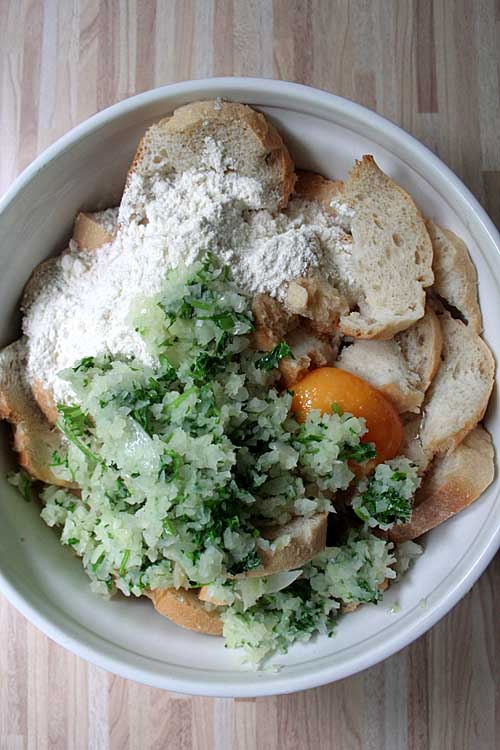
Step Four – Form the Dumplings
Add water and a dash or two of salt to a large stockpot. Wet your hands (for a better grip) and form 8-10 balls of the same size.
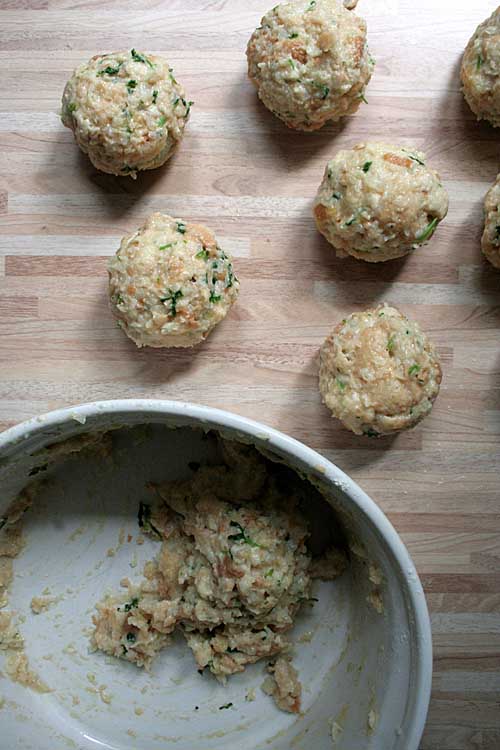
Place them in the boiling water and simmer over low heat for about 15 minutes.
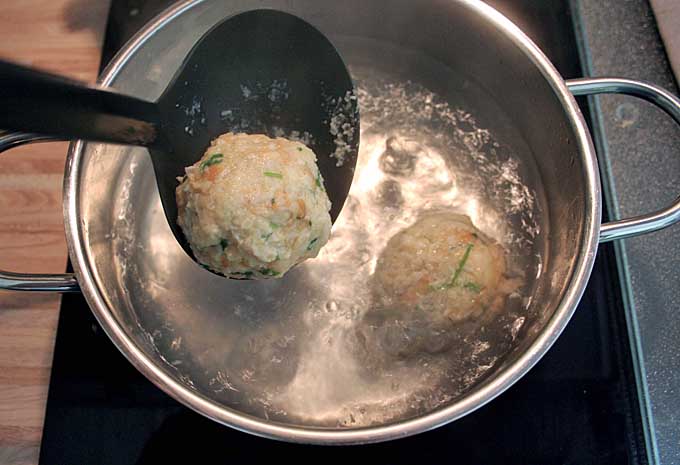
You’ll know they’re ready when they float up to the surface on their own and gently rotate. They should feel firm when you remove them from the water.
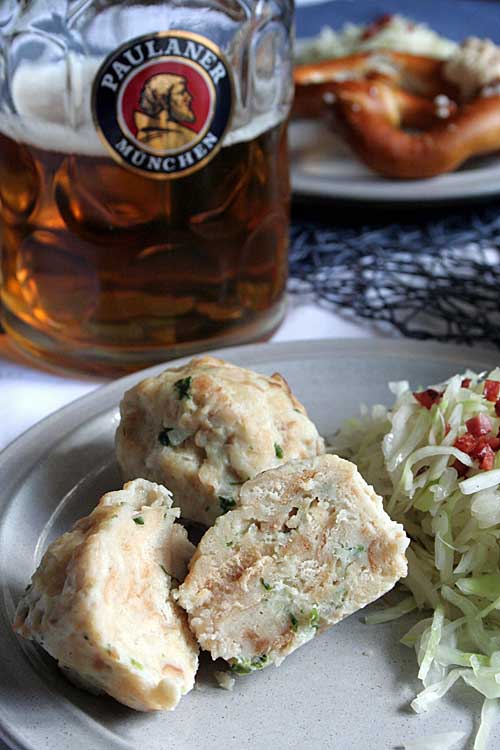
Whether you are using this to plan a menu for Oktoberfest or just for everyday fare, these dumplings are a perfect excuse to let your bread get too old!
There are bunch of different ways to prepare these – both sweet and savory. For the sweeter side of things, explore our desserty German Dampfnudel dumplings recipe here.
Have you had these before? If so what is your favorite way to prepare them? Tell us in the comments below!
Don’t forget to Pin It!
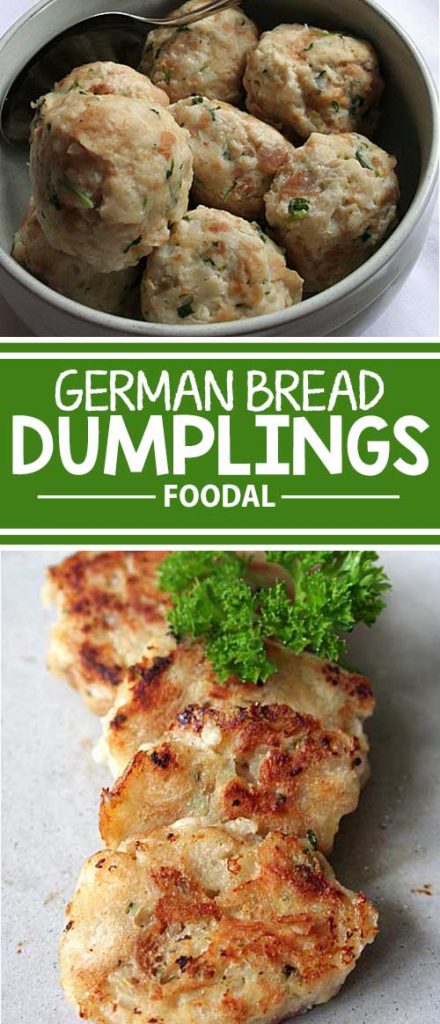
Photos by Nina-Kristin Isensee, © Ask the Experts, LLC. ALL RIGHTS RESERVED. See our TOS for more details. Additional writing and editing by Mike Quinn.
*Nutritional information derived from a database of known generic and branded foods and ingredients and was not compiled by a registered dietitian or submitted for lab testing. It should be viewed as an approximation.
About Nina-Kristin Isensee
Nina lives in Iserlohn, Germany and holds an MA in Art History (Medieval and Renaissance Studies). She is currently working as a freelance writer in various fields. She enjoys travel, photography, cooking, and baking. Nina tries to cook from scratch every day when she has the time and enjoys trying out new spices and ingredients, as well as surprising her family with new cake creations.


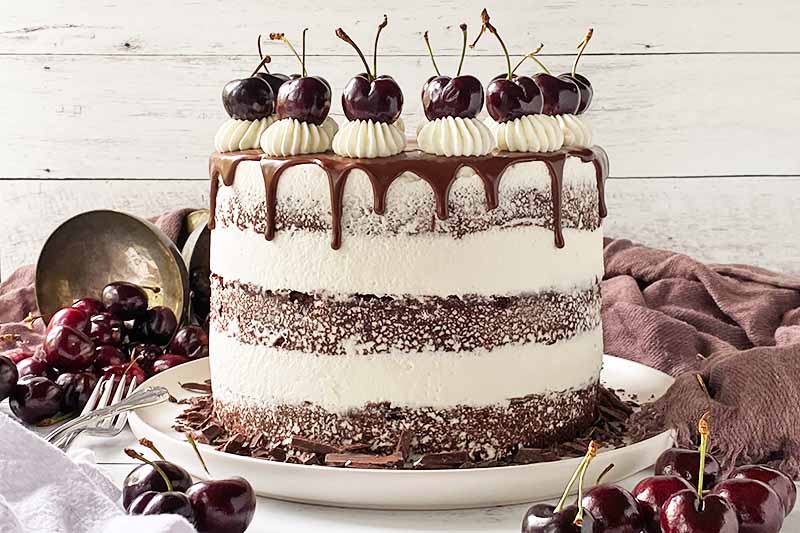


Oh my goodness my mouth is watering! I have not had these in years and had forgotten about them. You know, I would have never thought about using soft pretzels. I bet that gives it a very unique taste and can really spice it up if you’re not just not into white bread as it can be rather bland. I won’t even look at the nutrients! If I don’t know them I can enjoy it guilt free. My question is, would you use salted soft pretzels or unsalted as I know you can get both?
Hi Jordan, thanks for enjyoing this recipe. Indeed, using soft pretzels provides a nice twist to the usual flavor. Well, I think if you use salted ones, you can leave out the other pinch that is used in the recipe. Here in Germany, lye pastry is usually generously sprinkled with salt, so I sometimes just scrape off some of it 🙂
I haven’t heard from these ones before, it’s actually a really curious and delicious way to combine veggies and white bread. When it comes to me, I’m not the biggest fan of vegetables in general, so the fact that they are kind of mixed with the bread makes the whole process really easy.
It actually looks like a really easy to make recipe, I’ll try this one out! 🙂
Thanks for sharing.
My Grandmother makes these with pork and sauerkraut every New Years and they are tremendous. We call them “Clays”. This is the only place online I could find the recipe. Thank you so much.
My family and I grew up with the saurkraut and porkchops too. We don’t use milk but made them with water, eggs, salt, pepper and flour. Fried the chops then add water and put in oven. Made gravy with the pork juices.
My mother made these with sauerkraut and pork chops too. She didn’t use milk but used water, eggs, salt, pepper and little flour. She made brown gravy with pork juices then we topped with ketchup. My sister and I loved them, but we’ve never made them. Brings back memories. Thanks
Sounds delicious, Maralou. Glad we could bring back that memory for you. 🙂
My Slovenian grandmother made these and served them with goulash. If I remember correctly, after boiling she would lightly brown them in a fry pan with butter. So good. 50+ years later and it’s still my brother’s and my requested birthday dinner.
That’s SO Awesome! What an Amazing Memory!!????????Thanx for Sharing!!
Do these freeze well?
My mother made also. She passed at 54 and been trying to find the recipe. I’m extremely happy to find. She put dumplings around roast near the end of roasting and toss in juices and brown. I’m in Heaven now.
We’re so glad, Rick! Thanks for sharing your story, and enjoy the dumplings.
My mom made these with a pork roast and we put gravy over them. Delicious. I never got my mom’s receipe but this sounds just like it! Can’t wait to make it!
I’ve just made these – my first time ever making dumplings. They came out just like in the picture! I am English, but live in Germany, and up until now, have had to make do with eating these beauties in a restaurant. Now l can have them whenever l want! Thank you so much!
I’m always looking for bread dumpling recipes. The following has been passed down in my family for well over a hundred years:
1 long loaf bread – preferably white
3-4 cups milk
Flour – maybe a cup – depends on the moisture in the bread
1 or 2 eggs – beat well
1 teaspoon nutmeg
1/2 teaspoon salt
1 tablespoon sugar
Grease the kettle (mine has a bail handle and holds about eight cups of liquid) and set in a pan of water. Break up bread, as if for stuffing – allow to dry out overnight if possible. Mix with remaining ingredients- your hands work best! Dough will be rather sticky. Place in greased kettle, cover with foil or a plate. Place kettle in a pan of water and steam. Dumpling is ready when knife blade comes out clean. Turn out on plate, cut into wedges and serve warm with onion gravy and pork roast.
I was always told my frugal German relatives saved their ends of bread and rolls to make this!
These were great! Fantastic texture and perfect to go with a brat. Didn’t add onions and instead of parsley, used dill–because that’s what I had on hand. Created a simple cream, butter, and dill sauce as well. ???????? Great Grandma would be proud.
My mother made these with a pork roast for my Birthday dinner every year. My lifelong childhood friend will be making them for my 77th Birthday next week. My mother made them even more delicious by putting them in a hot oven for a while before serving them which gave them a little crispness on the outside. Scrumptious!
My grandmother was from Germany. She passed her recipe to my mom, and down to my sisters & I. Our version was a bit different using grated raw potatoes, grated raw onion, eggs, stale bread, salt & pepper. They were boiled and served with pork roast, gravy, red cabbage or iceberg salad with vinegar and oil dressing.
Can you give me your recipe? [Personal information removed by editor]. My stepfather used to make them your way. He’s now gone – I would love that recipe please.
Forebears from southern Germany too. Our recipe also used 1 or 2 medium grated raw potato added. Grandmother used lots of eggs maybe 3 or 4. Less milk and less flour or as needed to create a ball that will not fall apart in the boiling water. Never added nutmeg or parsley but think these would add flavor. Best ones were light but sometimes they came out heavy. I think the eggs had something to do with this. Always was served with pork roast and horseradish and applesauce. Recipe was always in controversy with different family members. Frying leftovers was always special.
I love them. I eat them with a mushroom gravy. Delicious
My German grandmother made these with pork and sauerkraut. So good!! We called them dough balls! I’m thinking of trying to make them this New Years day which was the tradition for my grandmother.
Sounds delicious, Jeanne! Enjoy the recipe, and happy holidays. 🙂
If you manage to have any leftover for the next day…do as was suggested and fry them up in butter until crispy, but then toss on a couple of beaten eggs to scramble with the crispy knoedel – my mother indicated that this is what her father used to be able to purchase in Prague when he was in medical school in the 20’s at any gasthaus – a cheap student’s meal. I always make extra so that I can have this the next day!
Exactly the way my mom and grama made them! Served with a pork roast and gravy and sauerkraut. Thanks for sharing!
I made this recipe with Gulasch and the kraut Salad. I did not turn out well but I think the rolls were too fluffy and ended up falling apart in the pot. I am good with traditional potato dumplings so I just took the mess and fried it with butter. I will give it another go.
My dad always made this for us but he made it in soup form. Said it was an old German family recipe. We always called it breadball soup. This sounds delicious though! I have attached the link to dad’s recipe if you’re interested!
https://www.netcooks.com/recipes/Soups/Bread.Ball.Soup.html
My Grandfather was from Austria/Hungary. He and my Polish Grandmother made something they called kneadles (sp?) which were white bread balls with water, flour, egg and navy beans! We’d have them with my Grandmother’s sour browned flour mushroom soup. I loved them even better the next day, as you described, cubed and fried in butter until the outside was crispy. I have never seen a recipe anywhere to confirm that anyone else ever ate them too … until now! Thanks so much for the memories and another variation on a dish I grew up eating.
German grandmother made very similar to these. But no eggs instead she finely shredded raw potato with hers. I do 5 small potato and 1 loaf bread and little flour. She boiled hers in water I use chicken broth. They fry so crispy and taste delish.
My father’s family immigrated from Austria and their descendants taught my mother how to make these. She always made them with white bread, small cubed Velveeta cheese, onions, flour, eggs, a little milk and salt and pepper. I understand that they can also be made with liver but us kids (55 years ago!) wouldn’t tolerate that! She would form them into a small fist size ball and then boil them in water (I add chicken bouillon cubes to my water for extra flavor- yum!!!) and then serve them with the broth as a whole meal. She showed me many times how to make them but sometimes my whole batch will still fall apart. I don’t make them that often (but what a treat for my siblings when I do!) I think I definitely need to use a heavier, more stale bread next time. Even the pieces are still delicious. If anyone can suggest something to help my dumplings stay together I would welcome any advice!
This is the recipe I’ve been looking for! We had these with roast pork and sweet and sour cabbage. Also with beef rouladen with a creamy dill gravy. I remember also my mom would have extra flour on the board and “press” or squeeze some around the dumpling before boiling. Yay can’t wait to make these again!!
Woohoo! Enjoy, Susan!